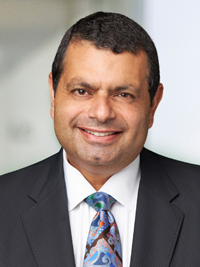Taking a pulse on healthcare capital investment: 3 insights
The pace of dealmaking in healthcare took a slower-than-anticipated start in 2025, given that three out of four healthcare leaders expected deal activity to rise.[1] But while increased cost of capital and regulatory uncertainty cooled the rate of transactions, there’s still a lot of appetite for healthcare investment industry thought leaders at the joint KPMG and HFMA Capital Conference agreed.
“We came into the year with a lot of enthusiasm and a lot of big ideas and plans,” said Ash Shehata, U.S. sector leader for healthcare, KPMG.
While there are still some market uncertainties, “There are a lot of things happening in the industry between private equity and healthcare providers and systems,” Shehata said.
“I am optimistic about the transformative potential of private equity,” said Glenn Mincey, U.S. leader for private equity at KPMG. “By applying capital strategically, we can not only enhance existing areas of specialization but also utilize acquisitions to drive healthcare businesses into new realms of specialization, foster innovation and tap into emerging markets.”
Looking forward
KPMG and HFMA brought together luminaries in healthcare and the capital markets in May, during the Accelerating Healthcare Investments with Private Equity and Venture Capital Conference, to discuss the trends shaping market activity and how to accelerate healthcare investments — including support from private equity and venture capital partners.
“We’re very excited to convene a select group of leaders in healthcare, private equity and venture capital to explore innovative pathways that drive innovation while protecting financial sustainability and the patient experience,” said C. Ann Jordan, JD, president and CEO, HFMA.
Here are three insights from those discussions.
1. Private equity is emerging as a partner for health system growth in open markets — but health systems should have a thoughtful exit strategy in mind.
“Everyone’s racing to get the best assets in the best ZIP codes, the best markets,” Shehata said. As the pressure for health systems to acquire enough assets to support their strategic vision ramps up, in high-growth markets like Florida and Texas, “Sometimes private equity partnerships are a force multiplier for health systems to be able to do that.”
The opposite is true in markets with complicated reimbursement models, where private equity exits are common.
“The message to those of us on the health system side is you’ve got to be ready for how you’ll dismantle [a private equity partnership], because when it’s over, it’s over,” said Robin Damschroder, president, value-based enterprise, and CFO, Henry Ford Health. “When the money goes away, all those patients are still ours. So I’m a huge pessimist when the money’s gone.”
It’s a scenario that speaks to the importance of trying to align a private equity firm’s exit strategy with the organization’s own strategy before a partnership is put into play. Establishing a defined exit plan well in advance could help avoid instances such as an abrupt exit, a no-win situation for health systems.
“Harmonizing the mission orientation of the health systems in this room with the return orientation of those nontraditional funding partners is where the rubber’s going to meet the road,” said Brian McGough, JD, senior managing director, Ziegler Investment Bank.
One area where healthcare could learn from private equity companies lies in their ability to identify and act upon market opportunities. This requires a thorough understanding of an organization from both an operational and a strategic perspective. It also involves a highly structured approach to value intervention.
“If private equity can bring lessons on how to create profitable structures, there is something there that I think we want to uncover,” Shehata said.
In 2025, KPMG expected mostly small- to medium-sized healthcare transactions as private equity firms and strategic investors worked to hone their value-based contracting capabilities and expertise; expand networks or services within networks; and explore opportunities to achieve scale by merging with other providers.[2]
“If you’re a private equity firm, to get an exit, you actually have to create value. Somebody’s got to buy what you’re selling. And that discipline is fantastic for the market,” said David Johnson, CEO, 4Sight Health. “I just wish we could put it all toward creating better, faster, cheaper outcomes at lower cost and with a better customer experience rather than focusing on how to play the reimbursement game more efficiently just to bring more revenue in.”
2. There could be opportunities for non-profit health systems to create for-profit entities.
“Just because a health system is not-for-profit doesn’t mean all the entities under the health system umbrella have to be not-for-profit,” Shehata said.
He shared an example of a health system CFO who lamented that a larger payer organization had entered the market and was employing its physicians. “I said, ‘Why don’t you go build a for-profit entity and bring your physicians into it?’ The CFO said to me, ‘Well, that would jeopardize our non-profit status.’ I told him, ‘That’s not the case at all.’ There are ways to create for-profit entities under the superstructure of a not-for-profit health system.”
While Shehata acknowledges that there are challenges in moving some assets to a for-profit model under a non-profit health system umbrella, “getting those two things to coexist might actually be the path forward” in a complex financial environment.
But McGough observed that organizations might face regulatory review for this type of approach depending on where they are located. Oregon, for example, recently enacted a law that restricts private equity investment in medical practices.[3] Organizations that are the largest employers in their communities have the political leverage needed to make these types of moves.
“I think we’re seeing a little bit of regulatory review to say, ‘We may not want private equity folks coming into certain provider spaces,’” McGough said. “And some of the definitions [of private equity in state regulations] are not necessarily clear — some might include a for-profit [entity] of a not-for-profit health system.”
The size of the for-profit investment or the proportion of for-profit to not-for-profit investments made by a health system also could trigger scrutiny, said Damschroder.
“Are you really mission-based and not-for- profit-based if you’re driving so much of your return off of these deals?” she said.
During the roundtable, there were also discussions regarding the potential for academic medical centers to either partner with for-profit entities or develop multistate or multiregional offshoots to expand the reach of their brand and increase revenue.
3. This will be a pivotal year for value-based care.
Today, interesting new models of care and payment are emerging from turmoil in the marketplace, said Johnson — and healthcare leaders, legislators and purchasers are paying attention.
“There’s a belief that the future of healthcare has to be different than what we’ve seen in the past,” Johnson said. “The new models we’re seeing are organized around two things: how to improve the end-user experience — because it [is abysmal] — and how to push better outcomes at lower cost with better customer service.”
This concept of value would ideally be attainable regardless of whether a payment model is grounded in fee-for-service payment or value-based reimbursement.
“If you actually deliver value, that’s how you deliver affordability,” Damschroder said.
The question on many participants’ minds: Is the current administration in or out with value-based care?
Shehata said in his discussions with Mehmet Oz, MD, administrator for the Centers for Medicare & Medicaid Services, “He was still pretty optimistic about it.”
If there is a future for value-based care, “We’re going to have to figure out which assets we can quickly grow with venture capital and private equity,” Shehata said. “And if there isn’t a future, we’re going to have to become really good at what we’re doing around transactional pricing and cost, and maybe we need to have better interoperability and payment processing, too, [to] become really efficient.”
Ultimately, healthcare leaders have to stop thinking about payment rates and start thinking about how to drive true costs down, Damschroder said.
That may be an area where private equity partners could play a pivotal role, she said.
“Care models do need to change,” she said. “If private equity can come up with the care models, it will accelerate change because it is very hard to get traditional medicine to change in less than seven or eight years. That may be an area of opportunity.”
Driving innovation with investment
As hospitals continue to face pressure to do more with less, success in determining the right investments for value — alone or with a partner — will come down to strength in leadership.
“Some leaders will look at this evolving landscape as an opportunity. They will say, ‘This is a chance to separate ourselves,’” said Marcus Whitney, founder, Jumpstart Nova, a venture capital firm focused on healthcare.
“It’s really about how responsive you are, how decisive you are, how much courage you have, and how much you believe your team has the assets to navigate to the other side and actually come out stronger relative to the rest of the field,” Whitney added.
Panelists
ROBIN DAMSCHRODER
MHSA, FACHE, CPA, is president, value-based enterprise, and CFO, Henry Ford Health, Detroit, Mich.

C. ANN JORDAN, JD
is president and CEO with HFMA in Downers Grove, Ill.

DAVID JOHNSON
is CEO with 4Sight Health in Chicago, Ill.

BRIAN MCGOUGH
is senior managing director with Ziegler in Chicago, Ill.

GLENN MINCEY
is principal with KPMG in N.Y.

ASH SHEHATA
is principal with KPMG in Cincinnati, Ohio.

MARCUS WHITNEY
CHFP, is founder of Jumpstart Nova in Nashville, Tenn.
Thank you to the following participants for their contributions and insights in the conversation.
HANY ABDELAAL
is president of clinical services with Commonwealth Care Alliance in Asbury Park, N.J.
MICHAEL ALLEN
FHFMA, MHA, CPA, is CFO with Hackensack Meridian Health in Edison, N.J.
CHARISSE DEAN
is managing director with KPMG in Pa.
CAMILLE FREMONT
is partner with KPMG in N.Y.
KATIE GILFILLAN
CHFP, is director, healthcare finance policy and education with HFMA in Downers Grove, Ill.
RICHARD L. GUNDLING
FHFMA, CMA, is senior vice president with HFMA in Downers Grove, Ill.
KIRSTEN LARGENT
CPA, is CFO with OSF Healthcare System in Peoria, Ill.
ROSS NELSON
is principal and national healthcare strategy leader with KPMG in Chicago, Ill.
TODD NELSON
FHFMA, MBA, is chief partnership executive and director of healthcare finance policy with HFMA in Downers Grove, Ill.
ANDY SHIN
is senior vice president, strategy, with Mass General Brigham in Boston, Mass.
MARIA TISO
is partner with KPMG in N.Y.
JAKE WOZNIAK
is treasurer and deputy CFO with The Ohio State University in Columbus, Ohio.
About KPMG
KPMG LLP helps organizations across the healthcare and life sciences ecosystem work together in new ways to transform and innovate the industry. Our client teams draw from more than 6,500 partners and professionals across a global network of 142 countries, and comprise specialists across digital transformation, strategy, finance, HR, IT, deal advisory, tax, audit, regulatory compliance, and risk management. To learn more, please visit: read.kpmg.us/navigatinghealthcare.
Footnotes
[1]. Smart optimism to smart diligence: Seeing over the horizon of a new deal market,” KPMG, January 2025.
[2]. Ibid.
[3]. Ibid.






